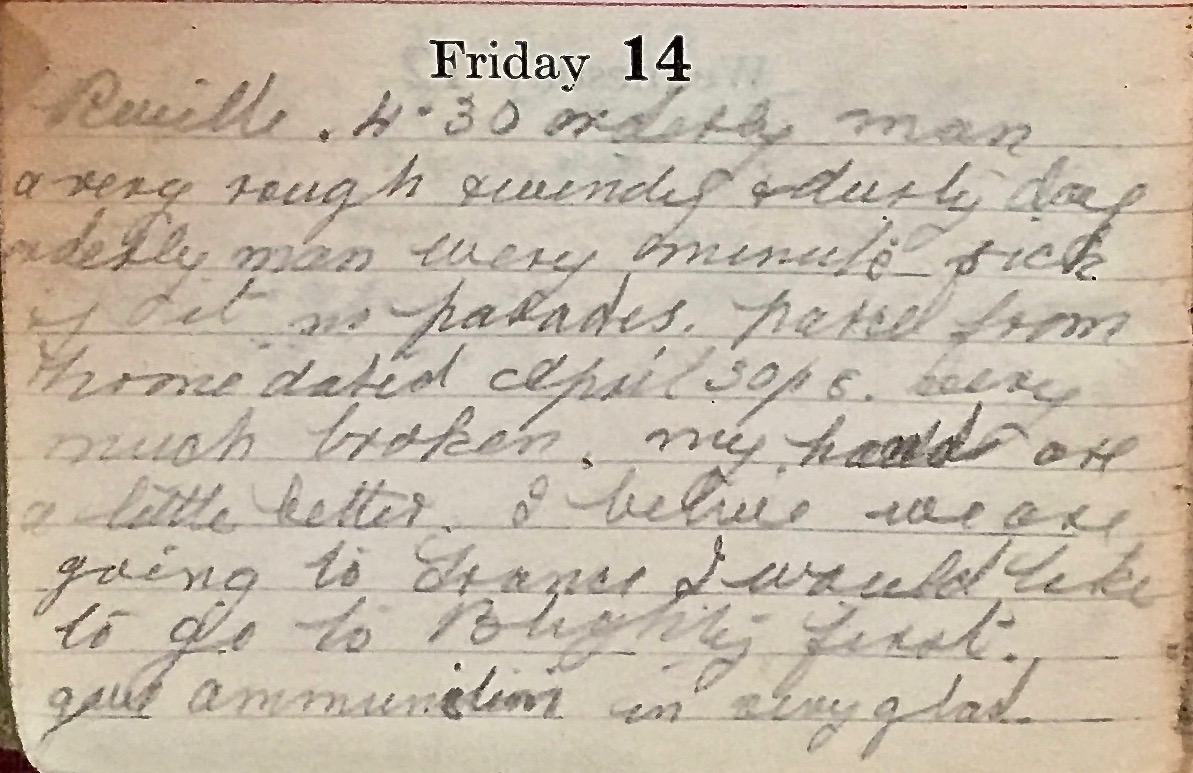Friday June 14th, 1918
Reveille 4:30 orderly man. A very rough and windy and dusty day. Orderly man – every minute sick of it. No parades. Parcel from home dated April 30th – very much broken. My hands are a little better. I believe we are going to France. I would like to go to Blighty first. Gave ammunition in – very glad.
Noble Cause
As reported a couple of days ago, war had been raging for over two years before the Allies published any war aims beyond ‘victory’. This omission had caused concern in some of the Dominions. According to the Guardian, ‘Throughout the Dominions, it is true, the doubts as to the actual purposes to which the policy of the Allies was directed, which had replaced the first glow of anger at the martyrdom of Belgium and the assault on France, have been notably dispelled by Mr Lloyd George’s speech of January last, in which he summed up the things for which we are not fighting as well as those for which were are.’
The article continued, ‘That speech strengthened the hands of the National Ministries which are led by Sir Robert Borden [PM of Canada], Mr Hughes [PM of Australia] and Mr Massey [PM of New Zealand], and especially in Australia, contributed notably to the stability of the Government. But that was a reclaiming of lost ground rather than a breaking of new.’¹
Conscripts & Volunteers in the Dominions

All Dominions raised volunteer armies and played considerable and important roles in WWI. All made huge sacrifices at home and abroad. However their reactions to conscription varied considerably. It is important to note that being anti-conscription did not mean being anti-war.³
This is illustrated by Australia. During World War I over 420,000 Australians served in the military with ~80% serving overseas, notably in Gallipoli, the Middle East and on the Western Front. Over 60,000 Australians lost their lives and 137,000 were wounded.² However when the Government twice put the possibility of introducing conscription for overseas service to the Australian people in plebiscites in 1916 and 1917 – on both occasions it was convincingly rejected.³

Canada raised an expeditionary force of 620,000 people during the war. It was involved in important and costly campaigns – particularly the Somme, Passchendaele, Vimy Ridge, Ypres and the final push on the Western Front. Over 67,000 Canadians were killed and 250,000 wounded.ˆ
The country, under a Conservative government, implemented conscription nationwide in January 1918. However the majority of the 400,000 potential conscripts across the country were excused on medical or other grounds. In Spring 1918, all exemptions were revoked. Eventually 125,000 were conscripted and less than 25,000 served overseas before the end of the war.¤ The whole issue caused considerable political unrest. This was particularly true in Quebec, where it effectively kept the Conservatives out of power in the province for the next 50 years.†
Newfoundland in 1914 was a Dominion of 242,000 people, of whom about 15% were of military age. The Royal Newfoundland Regiment was created in 1914 and saw service in Gallipoli and France. A uniformed pioneer battalion worked in forestry in Scotland from 1917. ‘During the First World War, the Regiment won 16 Battle Honours and 284 individual honours and awards. Of the 6,241 men who enlisted, 1,305 were killed, 2,314 were wounded, and 180 became prisoners of war.’‡ Small communities, much like with the Pals Battalions in various towns of Britain, were decimated. While conscription was introduced in May 1918, all of the 1,600 conscripts were still in training at the time of the Armistice.º

New Zealand was an early adopter of conscription through the Military Services Act of August 1916. All eligible men between 18 and 45 became ‘reservists’ and a ballot system was used to select from this pool. Over 138,000 men were called up through this system over the course of the war.¨ However, over half were rejected on medical or other grounds and in the end about 20,000 conscripts went to war.¤ Therefore 80% of the 100,000 who served with the NZ Expeditionary Force during WWI, were volunteers.ª

The photograph on the right shows men of the 2nd Auckland Battalion in a switch trench during the Battle of Flers Courcelette, September 1916.+
Despite its recent history, South Africa raised over 135,000 troops to the Allied cause during WWI. They fought in Africa, the Middle East and on the Western Front. The photograph on the left shows the men and mascot of the 4th South African Regiment at the Brigade’s memorial service at Delville Wood, February 1918.^^ However, as the Guardian noted, in respect of conscription ‘in South Africa, for obvious reasons, it has not been mooted.’²
13th (Service) Battalion War Diary – 14th June 1918 – La Marraine
Work and fatigues as before.
References & Further Reading
¹ Article entitled ‘The Imperial Conference’, June 12th, page 4, The Guardian newspaper.
² Conscription at State of Victoria Library
³ Military History of Australia in WWI on Wikipedia
ˆ Military History of Canada in WWI on Wikipedia
¤ It is worth noting that medical rejection rates of conscripts were high in Britain too. This was partly due to the health of the remaining, non-service population in the later years of war.
† Conscription Crisis in Canada on Wikipedia
‡ 1918 – End of War, Newfoundland & Labrador in the First World War
º Recruiting the Newfoundland Regiment on-line
ª Recruiting & Conscription on NZ history site
¨ Military Services Act, NZ History
* Canadian Soldiers returning from Vimy Ridge from Canadian Encyclopedia (image may be subject to copyright)
** Q112876 copyright Imperial War Museums
# HU 113700 copyright Imperial War Museums
+ Q 194 copyright Imperial War Museums
^^ Q 10676 copyright Imperial War Museums


